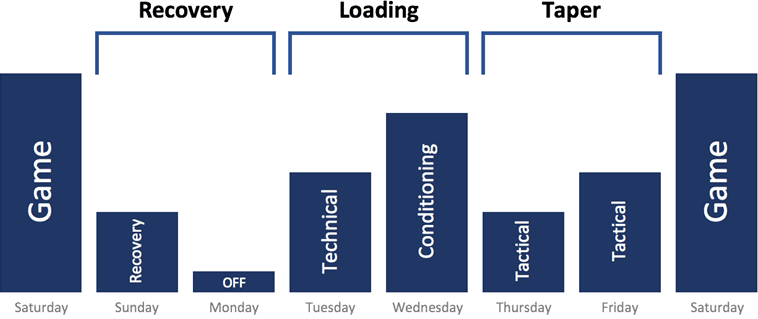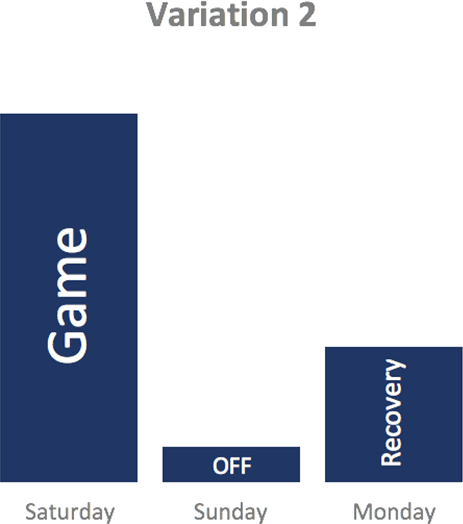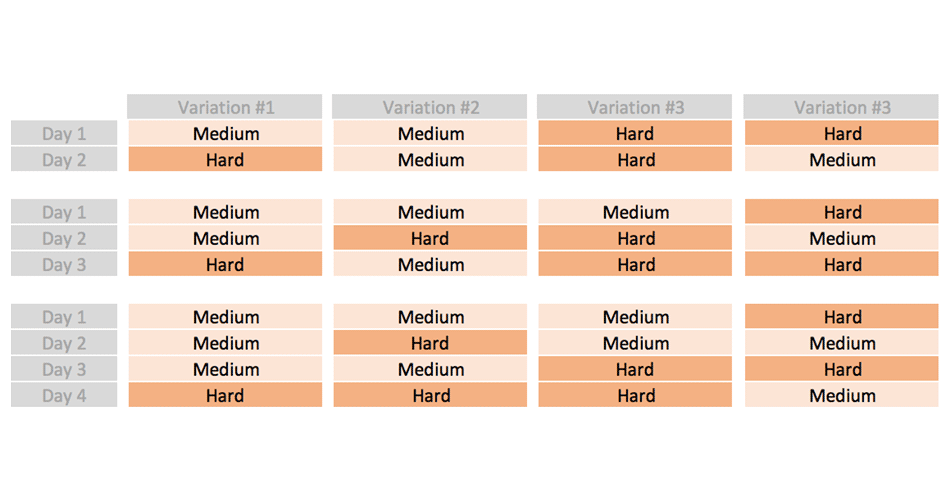Physical Preparation for Team Sports: Weekly Plans (Part 1)
As I promised in Working on a Book blog post, I will post chapters and text pieces of the new upcoming book. The order will be a bit hectic, but there is some “grand design” to it all. In the following piece, I am discussing weekly plans and the principles behind their design. This piece covers overall principles and recovery and loading mini-blocks. Comments and feedback are, as always, welcome.
By the week plan term, I do not necessarily refer to the calendar week of 7 days, but to a period between two games, that can last from 3 to 14 days. Since we are usually dealing with a varied competition schedule, we need to rely on a couple of principles and heuristics when planning the week.
Mini-Blocks inside the week
Training week can be further divided into three mini-blocks: (1) recovery, (2) load, and (3) taper.

Each mini-block have a specific purpose, but also a specific variation that could be implemented (but the whole week needs to be taken into consideration). In order of importance, we are planning for the recovery mini-block first, then the taper mini-block, and if there are extra days left we can schedule the loading mini-block. This depends on the duration of the week plan and other circumstances (e.g. extending the recovery phase to give players extra rest after the dense competition period).
Recovery Mini-Block
The purpose of the recovery mini-block is both physical and mental recovery. The game can be very taxing on both, sometimes more emotionally taxing than physically. For example, consider playing exact same very physical game and either winning or losing it in the last 5 minutes. Based on the game outcome, the fatigue can be different, even if the game’s physical load is the same. Hence, if the team is on the winning streak they are much more receptive to training loads or tend to recover faster from ordinary training loads, and vice versa for the team that is on the losing streak. It is unfortunate that losing teams tend to ramp up the training load when even the ordinal load can be challenging in those periods.
The recovery mini-block also helps to cool the heads after the game and different variations can help, more or less, in this regard. Games can become very emotional, and cooling the heads before the game analysis can help bring more objective feedback.
It is known both from practice and research that the highest fatigue happens on the 2nd day after the game. This is an important insight to keep in mind and we can take this into account in different ways when we plan the recovery mini-block.
There are pretty much two variations of the recovery mini-block, depending on the order of the day off and recovery session and they take different solutions to the above problems, as well the transition to the loading mini-block.
Recovery Mini-Block: Variation 1
The first variation of the recovery mini-block schedules the recovery session on the first day after the game and follows up with the day off.

Since the fatigue peaks on the 2nd day, it makes sense to give players a day off on that day. The recovery session (could be active recovery, like easy strides, football tennis, or completely passive, like massage, hydrotherapy and stretching) is planned on day one after the game. During this time, the game review can be planned, but sometimes the heads are still not cool to do so. Depending on the game finish time, this session could be planned in the morning, but if that is going to affect the sleep duration after the game (for example in late finish the players are not able to fall asleep till 3 or even 4 am) it is better to schedule it later in the day since sleep is the recovery priority number one. One heuristic that could be used on the away game is that if the team can make it home by 2 am you can travel, otherwise you can stay away and schedule the recovery session in the morning and then travel back home. This is because in the late-night game, the players are usually unable to fall asleep until late in the night. Again, this type of decision can be made with the players themselves since they might prefer to travel even with the late arrival to avoid missing time with their families and so forth.
This brings me to another point – the selection of the variation of the recovery mini-block depends not only on the recovery or biology but also on logistics (maybe even more). What we also need to consider are the players that are not playing (or played less than 60minutes) or are not traveling. The idea is to put them on the same or similar training load pattern of the playing group as soon as possible. In the ideal world, the non-playing players could stay after the game immediately and do some hard conditioning sessions, but most of the time this is not a very motivating solution. So, they might train on the very next day while the rest of the squad is having the recovery session. So taking this logistic into consideration is very important.
Another issue might be the day off for the coaching and support staff (medical, physiotherapists) as well. A good manager should take that into consideration. Depending on their number, certain staff can rotate (i.e. have a day off on a different day) if it is impossible to give everyone a free day.
Another crucial issue to consider are the injured players. Having the recovery session the very next day can work well since injured players need to show up for a check-up with the medical staff. This is a bit tricky with the following variation where the first day after the game is the day off.
Recovery Mini-Block: Variation 2
The second variation reverses the order of the recovery session and the day off.

This variation has both pros and cons as variation number one. For example, in theory, it might be used to delay usage of the recovery means right after the game to allow for adaptation to take place and not to blunt the signaling with recovery procedures. Then on the second day, where the fatigue peaks, we can schedule the recovery session. I am not aware of any study that compared immediate recovery strategies versus delayed recovery strategies in terms of adaptation responses and recovery markers, so it might be something to experiment with. As with everything, this decision (to use variation one or two) might be made with the playing group to see what they prefer and change it when needed. Involving players is always a good thing if you ask me.
The good thing with giving a day off immediately is that heads can be a bit cooler for the meetings and game review on the second day, and this can give extra time for the performance analyst to do their job. Doing some active recovery on the second day allows for the “engines” to warm up for the loading mini-block, as opposed to having the day off. The negative aspect is that athletes might have more days in a row at the training ground leading up to a game, and this can become burdensome in the long seasons.
Having a day off on the first day after the match might create some issues with the injured players, especially if the medical staff is given a free day as well. Otherwise, both injured players and medical staff, if arriving on the training ground loses their day off.
Recovery Mini-Block: Variation 3
Variation three is pretty much a combination of the above two. For example, the decision on what to do on a given day might be given to players (at least for the playing squad). Either they can do recovery on the first day or the second, but they must do it. Or they can have two days off. The only issue might be if there is some active recovery planned (for example foot tennis) and the coach needs to know exact numbers.
Injured players or those seeking medical examination and advice can show any day, as needed. The non-playing players might need to top up the training load by doing SSGs or HIT conditioning on either day (decided by the coach, and how it blends to the loading mini-block).
But to make this variation possible, one needs to have enough staff, so someone can be available on each day and rotate the days off for them as well.
Recovery Mini-Block: Summary and Conflicts
On the following picture, there are all three variations presented with potential conflicts highlighted in red.











Responses